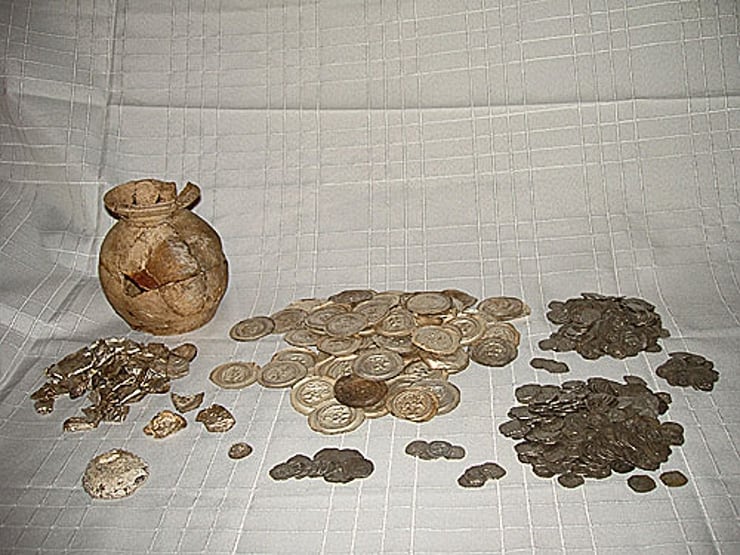Nález se našel na místě zvaném Zlatý kůň, traduje se že v místech kde ho Míra Hána s kamarádem našel, byla též i penězokazecká dílna. Podporuje to i teorie nalezených několika slitků stříbra které byli součástí peněžního depotu...Tenkrát jsem byl s kamarádem i na premiéře výstavy, než byl poklad vystaven pro veřejnost v Berounském muzeu, a pan Militký měl kromě zpracované publikace i velmi skvělou komentovanou prohlídku.. 
28 Sep 2006 Speleologists discover over 800 coins
Categories: Minting - Numismatics , Treasures , Finds and rescue research in the Czech Republic , Calendar

The treasure from the thirteenth century was acquired fifteen years ago by the Central Bohemia Region. Over 800 silver coins were discovered by two amateur speleologists while searching for new caves. The hoard was found in a ceramic container hidden under rocks.
The coins were discovered by Miroslav Martínek and Miroslav Hahn. "At the first moment, I could only make out some wheels peeking out and only when I focused more closely did I see some kind of a dwarf on them. I told Mirek that it looked like silver. The vase was broken and the shards were lying around the coins," Hahn described the first moments after finding the extraordinary treasure.
They immediately informed the Institute of Archaeological Preservation about the discovery. They took it for granted, and according to the finders, everyone who comes across such a treasure should do the same. "If the find is not removed by archaeologists, it is devalued," Hahn stressed.
The treasure was left in place and reported. "From the second day onwards, we, as a group of archaeologists and finders, were able to inspect the site and retrieve the treasure. It's the only find that contains two components, thin brittle bractates and phoenicals, and it's the only find from that time that we have managed to save the treasure in its entirety in several decades," said archaeologist Jiří Militký
The coins probably belonged to a wealthy merchant from Germany who kept them and never returned for the treasure. He may have been attacked and killed by robbers from whom he hid the silver coins. The depot contained Meissen coins and Riesen pfennigs. The depot otherwise included coins of known and unknown mintage from the mid-thirteenth century.
According to an expert opinion, the treasure was worth 2 290 500 crowns. The finders thus received a reward of over two hundred thousand crowns from the region. "I discovered the find with my colleague Miroslav Martínek. We often find archaeology from different periods, whether from prehistoric or medieval times. This is the first time we have found coins," Hahn admitted.
Back in the 1980s, Hahn discovered a sanctuary containing remains of bones and pottery while searching for caves on Bacín Hill in the Beroun region.
In terms of the local history of today's Berounsko region, the Tetín find represents an exceptional source for understanding the period in which the local region and the whole country were transformed on a large scale. During the first half of the thirteenth century, the position of the old Přemyslid centre of Tetín was transformed by the establishment of the royal castle. The origins of the town of Beroun seem to date back to the same period.
Sources: www.mince-bankovky.cz, Právo, www.denik.cz, www.ahaonline.cz
The article is included in categories:
- Archive of articles > Minting - Numismatics
- Archive of articles > Treasures
- Archive of articles > Archaeology > Finds and rescue research in the Czech Republic
- Archive of articles > Calendar
Post
Odhad a nalezne výsměch jsem z Berouna tak vim kde to bylo,nasrat státu






